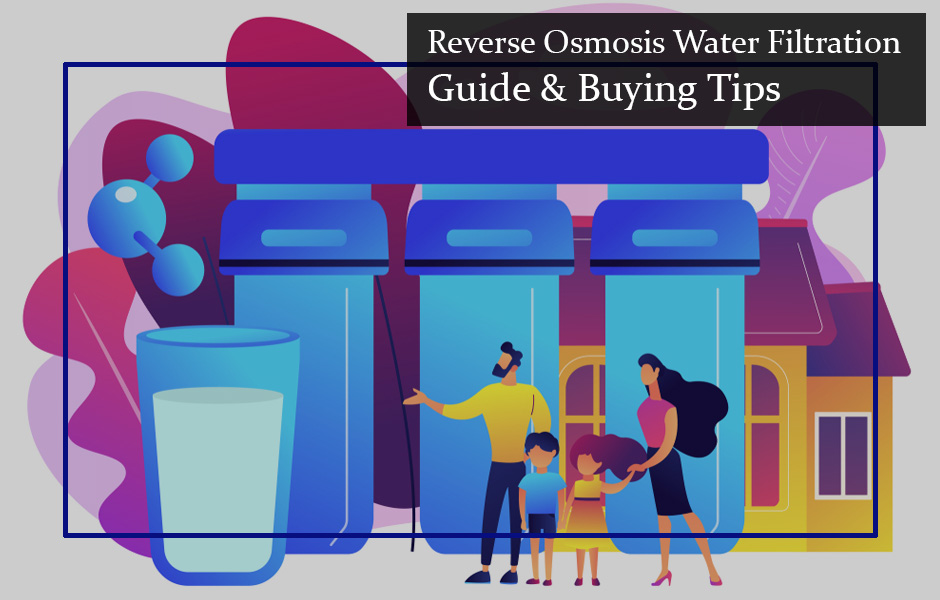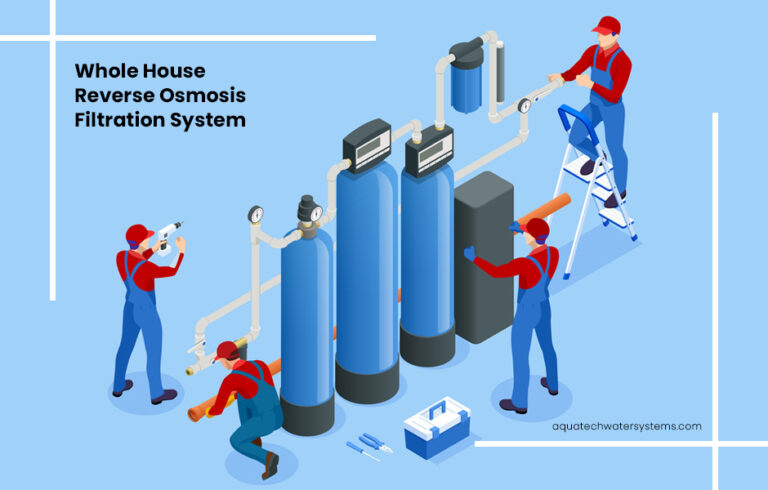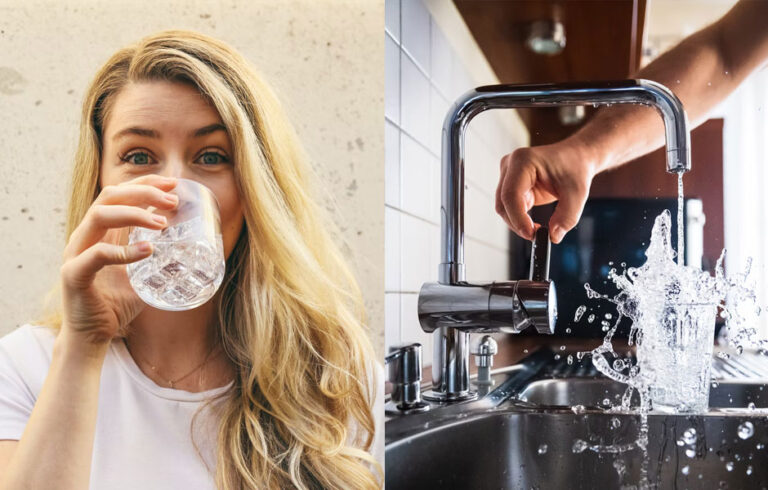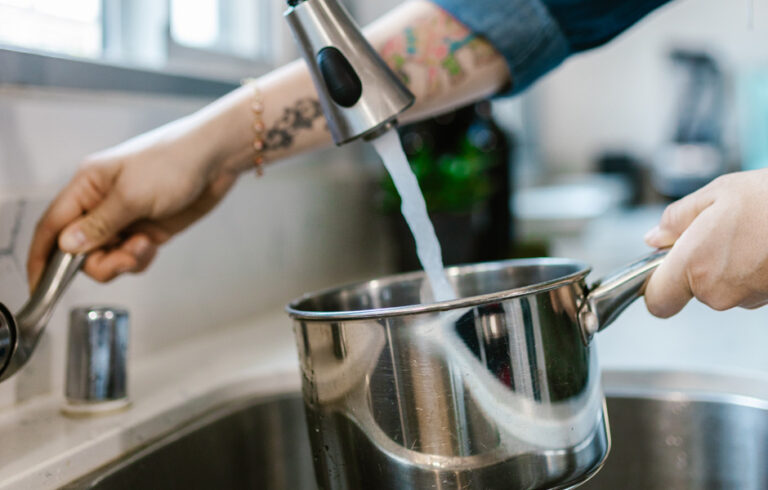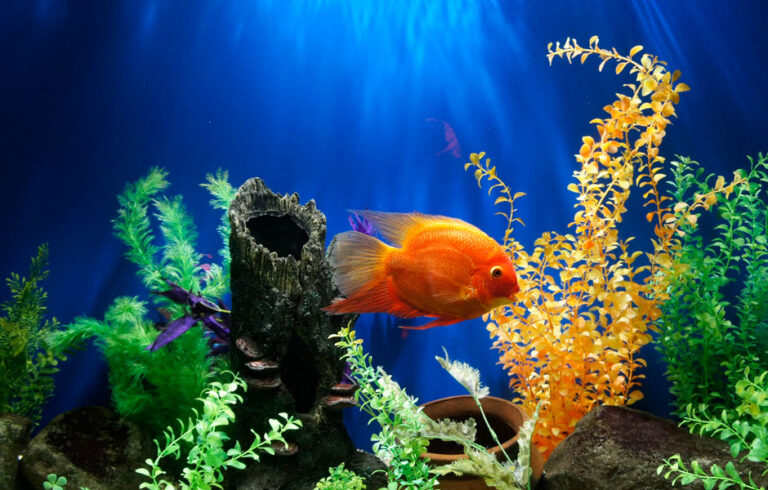Nowadays, there seem to be too many factors threatening the health of humans. From the air we breathe to the food we eat and even our drinking water.
Various studies have shown the dangers of drinking contaminated water, and hence many water filtration systems have been developed in recent years.
This article will discuss one of the most extensive water filtration systems – the RO water filter system – its benefits, and the features that make it different from other water purifiers.
In this article we will cover:
- What is a Reverse Osmosis water filter system
- How does reverse osmosis filter work?
- Difference between RO and other filtration systems
- Is RO water good for health?
- Should you get an RO?
- How to choose the best RO system
- How to use and maintain an RO water filter
- FAQs on RO
What is a reverse osmosis water filter system?
Reverse osmosis (RO) water filter system is a water purifier that removes impurities and contaminants from water by applying hydraulic pressure. This pressure forces water to pass through a series of artificial semi-permeable membranes, thereby leaving behind contaminants.
Just like its name, reverse osmosis filtration reverses water flow through the process of osmosis. The system passes water from the point of a heavy concentration of contaminants to low concentration, thereby producing cleaner water.
Why is RO so popular?
Due to the dangers of drinking unhealthy water, many households in the United States have taken their health into their hands by producing their own safe drinking water. This paved way for several water purification systems and water purifiers, including RO which has become very popular.
The Center for Disease Control (CDC) identifies several water purification methods, including water purifiers, ultraviolet filtration, distillation, carbon filters and RO. However, the reverse osmosis (RO) water purifiers, such as the Aquatech’s 5-stage RO filter system, are considered the most efficient water purification.
RO filters use unique semi-permeable membranes to remove contaminants while also purifying water with very high TDS (Total Dissolved Salts) levels – giving you one of the purest drinking water.
How does a reverse osmosis filter work?
The best way to know how RO works is first to understand the concept of osmosis.
Osmosis is the natural process through which water is passed through a semi-permeable membrane. The process forces water to move from a region of lower concentration to the region of higher concentration. You can picture this from how plants absorb water.
However, in reverse osmosis, the opposite is the case. Instead of increasing concentration, water is forced to move to lower concentration as the RO membrane blocks contaminants from passing through it.
The reverse osmosis filter system is more effective in removing dissolved solids, particles, and solvents than other filtration methods because of the pressure applied and the selective feature of the membrane.
It incorporates the semi-permeable membrane technique with a series of carbon filters. These are known as pre-filters or post-filters, depending on the stage where they occur in the filtration process.
The resultant water with less concentration of contaminants is known as permeate, while the other part with high concentration is called the brine or the waste.
Stages of the RO system
A typical RO system is made of 1 to 5 filtration stages. The most popular are the 3, 4, or 5 stage RO systems. As expected, 5-stage reverse osmosis produces the highest water purification level by adding back essential minerals in the fifth stage.
All reverse osmosis systems work using the same underlying principles, including one or more sediment filter, carbon filter, and the RO membrane.
1st Stage – Sediment filter
This is usually the first stage (pre-filter) in the RO filtration process. It is the stage where visible contaminants such as silt, debris, rust, dirt, dust, and other sediments are separated from water coming from a source of water supply (e.g. well or tap)
2nd / 3rd Stage – Pre-carbon filters and RO membrane
The carbon filter and the RO membrane works to remove chlorine, Volatile Organic Compounds (VOCs), and other impurities that may affect the color or odor of water. These stages include the pre-activated carbon filters, the RO membrane, and the activated carbon filters.
4th Stage – Semi-permeable membranes
At this stage, further removal of harmful chemicals (such as fluoride, lead, and chromium) and other elements occurs as water is forced through the semipermeable RO membrane. This stage removes about 95 to 98% of Total Dissolved Salts (TDS) in water.
5th Stage – Post filtration
Here, the water passes through a final filtration membrane that removes any more particles that may have escaped all other filtration stages. Most 5-stage RO systems use a remineralization process to add vital minerals that may have been removed back into the water at this stage.
At the 5th stage, our RO water filters use granular activated carbon filters with a unique mix of carbon derived from burnt coconut shells.
6th Stage – Enhanced alkaline filtration
At the 5th stage of the RO process, the water produced is pure, healthy, and good for drinking. However, some RO filters offer an additional 6th stage for remineralization and alkalization. Since the RO process is believed to have striped water of certain minerals, the 6th stage is included to add back essential minerals while also reducing water acidity to make it alkaline. Alkaline water has numerous advantages, including improved hydration and antioxidant benefits.
The 6th stage is a highly innovative water polishing filtration process that increases water ph. and lowers the Oxidization Reduction Potential (ORP), thereby enhancing hydration. Aquatech’s stage 6 filtration is optional and can be applied at the end of your RO system.
Components of an RO System
These are fundamental components that a typical RO water purifying system should have to allow effective functioning.
- The inlet or feed valve: This is the cold-water line valve connected to your water source, usually a tap.
- Filters: Includes all the filters such as the sediment filter, pre-activated and activated carbon filters, and the RO membrane.
- Pressurized storage tank: This is where the RO filtered water is stored and made readily available for your consumption.
- Drain valve: The drain lets out the impure water produced from the filters through a special outlet.
- Automatic shut off valve: This valve shuts off water flow from the RO once the tank is full. The pressure of the storage tank activates the shut-off valve.
- Check Valve and flow restrictors: The check valve prevents the backward flow of water from the storage tank to the filter while the flow restrictors help maintain pressure in the membrane.
- Outlet: This is where you collect your purified drinking water – Ex: kitchen sink or auxiliary faucet.
Difference between RO & other filtration systems
Without a doubt, all water filtration systems are not created equal. The difference between the RO filter and other filtration processes is in the technology involved and the quality of water produced.
RO vs. Distillation
CDC describes the distillation system of filtration as the process of heating water until it boils so that the condensed water vapor is cooled and collected, leaving behind contaminants such as lead and calcium.
Compared to RO, distillation is usually ineffective in removing organic chemicals and is also a prolonged filtration method. Also, distilled water often tastes bland as it contains no nutrients minerals.
RO vs. Carbon filtration
When comparing RO with ordinary carbon filters, the main difference is in the filter’s pore size. While carbon filters can remove over 80% of contaminants sized 0.5 to 1 micron, reverse osmosis removes up to the size of 0.001 microns. This reveals about 500 times difference in filter pore size, making RO filters more efficient in removing impurities.
Carbon filters may be unable to remove arsenic, dissolved solids, fluorides, and viruses, while RO filters remove them effectively.
RO water vs. Bottled water
Plastics used in bottled water can produce toxic chemicals that are harmful to health, especially when they’ve been exposed to heat. Moreover, it is hard to determine what method of filtration has been used by the bottling company; hence, one can not be sure of the water’s quality.
In addition to this, there have been reports of outbreaks attributed to bottled water consumption, which means this type of water may not be entirely safe for consumption. Overall, the RO is more environmental friendly than bottled water and eliminates the need to visit groceries before gaining access to drinking water.
Also read: Detailed comparison of bottled water with RO water
RO vs. Ultraviolet (UV) rays water purifier
UV filtration uses ultraviolet rays to kill bacteria, cyst, and viruses present in water but not dissolved chemicals, nitrates, or other heavy metal impurities. When you are not confident that the TDS level in your water is safe for consumption, it is advised to opt for RO drinking water system in place of UV water purifiers.
Unlike the UV filter, RO eliminates bacteria and viruses from water by killing them. It also filters them out, so they do not enter into the purified water.
RO vs. Tap water
Tap water in the United States is regulated by the United States Environmental Protection Agency, making the US water system one of the safest water supply sources in the world. Despite the EPA regulations, water contamination can still occur through the piping system, local land-use practices, sewage releases, or even naturally occurring minerals.
For this reason, purification becomes necessary to avoid contracting water-related illnesses. The RO water filtration effectively purifies tap water producing pure drinking water free from any form of contaminants.
RO vs Ultrafiltration (UF) water purifier
Unlike the UV system of filtration, the UF purifies and removes all bacteria and viruses in water. The major difference between the UF water purifier and RO is that the former cannot remove dissolved salts and other particulate matter; hence it is not effective in eliminating TDS.
RO vs. Alkaline water
Both RO and Alkaline water are forms of filtered water. Alkaline water is water with reduced acidity. Diseases tend to thrive in an acidic environment, and so drinking alkaline water, which has reduced acidity, is beneficial in maintaining one’s health.
But what is the difference between alkaline water and RO water?
The process of alkalization does not necessarily remove impurities from water. However, our reverse osmosis filtration systems have a different alkalization stage that reduces water acidity while also removing contaminants. Therefore, drinking RO water from Aquatech RO systems is synonymous with drinking Alkaline water without giving up the benefit of having purified water.
RO vs. Water softener
Water softeners generally remove certain minerals (like calcium and magnesium) from water to make it softer for bathing and doing laundry. Water softeners do not remove impurities or contaminants from water as in the reverse osmosis system.
As an advantage over water softeners, RO also softens water during the filtration process. If you have hard water, it is advisable to install a water softener before treating your water with Ro to remove iron from water that can clog your RO filtration system.
Further reading: Reverse Osmosis Vs. Water Softener
RO vs. Inline filtration
Inline filtration uses carbon to filter to reduce chlorine and improve the taste of water. While inline filtration is effective in removing impurities to a large extent, it does not necessarily remove contaminants such as lead and arsenic.
Generally, it is the RO membrane that makes it better than most other filtration systems. The RO membrane removes dissolved salts from purified water – an advantage other filtration systems do not possess.
Also read: The difference between distilled water and deionized water
Is RO water good for health?
Several studies indicate that there can be over 80 contaminants in treated drinking water that may be harmful to human health. While some of these contaminants may result in acute health effects that occur within hours or days of consumption, others have chronic effects that surface after consuming such contaminated water over the years.
Reverse osmosis water filtration system removes contaminants from water, including the unseen impurities that may affect one’s health adversely.
What harmful contaminants does RO remove from water?
Some of the contaminants that RO removes from water include;
- Arsenic
- Dust and mud
- Chlorine
- Fluoride
- Volatile organic compounds (VOCs)
- Dissolved Salts/ heavy metals: lead, iron, cadmium, mercury
- Sediments and
- Herbicides
- Bacteria: water from a public supply system is expected to be free from bacteria. However, if you suspect that your water may be unsafe, it is advisable to combine RO with UV disinfection.
An efficient RO water system is expected to eliminate up to 99% of all impurities in water, including those listed above.
- RO water has low reduced sodium: Another reason why RO water is good for health is the reduction of sodium, especially in soft water. A low level of sodium content in water helps reduce the risk of diseases such as kidney problems, liver disease, and high blood pressure.
- RO water tastes better and is free from odors: One of the most important benefits of RO purified water is the taste. The reverse osmosis process eliminates any impurities or minerals (like chlorine and lead) that may give your water a bad taste or odor. Hence, RO water is not only pure but also better tasting.
- RO water is economical: Not only is RO water good for your health, but it is also good for your wallet. Compared to the cost of buying bottled water over time, or the amount that will be spent treating health issues related to drinking impure water, the cost of drinking RO water is much cheaper. More than that, RO filters are effortless and inexpensive to maintain.
Are there hidden drawbacks of using RO water purifiers?
While RO has a few disadvantages, these are not substantial enough to conclude that RO water is harmful to drinking. Below are the possible limitations of RO water purifiers
- Wastes water: No doubt, the reverse osmosis systems produce a tangible measure of wastewater during the filtration process. For every 2 liters filtered using an RO, one will get only one liter of pure drinking water. The 50% water rejected can be used for other purposes like gardening, washing toilets, or mopping.
- Requires electricity: An RO system requires electricity to function. This may not necessarily be a disadvantage if one considers that some other water purifiers use electricity too, yet they do not purify at the same quality. Usually, RO systems have a storage tank that makes water available for use even when there is no electricity.
- Removes minerals: RO removes minerals like calcium and magnesium, but this does not constitute any detriment to the body. Food, not water, is the primary source of essential minerals. An average adult will have to drink excessive amounts of water to get significant any significant mineral content.
Why should you get an RO?
Though the United States has one of the safest public water supply systems (PWS) globally, the Center for Disease Control (CDC) confirms that public water systems can be contaminated even after being treated. Drinking such contaminated water may result in adverse health effects. Hence, having a water purification system that can produce healthier drinking water like the RO is essential. So yes, you should get an RO.
There are several other water purification methods, such as distillation and carbon filters, but the RO tends to be the most extensive and can remove up to 99% of contaminants.
The health issues related to drinking contaminated water makes it essential to obtain extensive water purifiers like the RO. Some of the benefits of getting an RO includes;
- Eliminates dissolved salts and solids in water
- Reduces TDS in water (according to the EPA, TDS in water should not exceed 500 parts per million)
- Eliminates bad odor and taste
- Reduces the sodium content of water
- Nitrates – this is even more beneficial if your water source is a private well. An RO system is helpful to ensure that your drinking water is free from impurities such as nitrates.
More benefits of RO include:
- Very easy to install. It can easily fit under your kitchen sink or placed on a counter
- Has a long lifespan with zero maintenance and is cheap to operate
- It produces high-quality drinking water without the risk of drinking water from plastic bottles
- RO is environmentally friendly as it eliminates the risk of generating plastic wastes
- RO gives you peace of mind that comes with an assurance of pure, healthy water
How to choose the best RO system
Some of the factors you should consider before choosing an RO include the purpose, the location (where to install the RO), the type of RO, the purpose, and the cost. Let’s take each of these factors one after the other;
1. Purpose of RO
ROs are of different types depending on the purpose. Typically, we have RO for homeowners (residence), assisted living, RO for businesses, schools, and a host of others. Below are types of RO systems are classed based on the places where you can use them.
RO for commercial
Drinking healthy water is not exclusive to homeowners only. Businesses and organisations can also install RO systems to make pure drinking water available to employers and employees.
RO for agricultural use
RO can be utilised for those involved in hydroponic farming or greenhouse as it helps control the amount of nutrients for plants. However, RO is not advised for general agricultural purposes.
RO for aquariums
It is possible to use RO water for an aquarium to ensure that the fish are kept in pure water with regularized salt quantity. Aquarists use both RO and deionization to create a perfect or near-natural environment for their fish. This may involve the use of a demineralizing filter and Ro/DI water.
RO for remote use
You can also choose RO to be used remotely either at campsites or extreme locations. The use of reverse osmosis in RVs may also require UV treatment to kill bacteria.
RO for residence or homeowners
As a homeowner, there are many options on where you can install a RO water purifier, but these will depend on your preference. You may consider the convenience and space in choosing any of these options.
2. Location (Where to install your RO?)
If you have decided to obtain a reverse osmosis water purifier, you should understand that the systems are typically installed at the Point of Use (POU). After you have decided what type o RO you require (whether residence, commercial, etc.), you will need to consider where you want to install the system. You have to consider factors such as convenience and space in choosing any of these options.
Under the sink RO
The kitchen faucet is one of the most common outlets for RO filter water in homes. Therefore, you can install the RO under the kitchen sink or the bathroom sink, depending on your choice.
Refrigerator RO
You can also connect an under-sink RO to your refrigerator.
Countertop RO
You can install a RO water filter on a counter or cabinet depending on your choice.
RO for wells
RO is an excellent method of water filtration for homeowners whose water source is from a private well
Wall-mounted RO
As the name suggests, this type of RO is mounted by a wall and usually has a storage tank for keeping clean RO water.
3. Cost of RO water filters
Either you stay in your apartment, home or a rental, there are two RO filter options that you can explore:
- Buying an RO or
- Renting an RO
The cost involved in buying or renting an RO is one of the major factors you should consider before deciding to install an RO. This may consist of the initial cost, the installation cost, and the maintenance cost.
Initial cost: This is the price at which you purchase the RO filter system. The cost of purchasing and RO varies across different brands and types.
- Cost of under sink ROs: Under-sink RO prices range between USD500 to USD1, 000. Usually, commercial under-sink ROs cost more than residential.
- Cost of Countertop ROs: These are some of the cheapest types of ROs. The cost of a typical countertop RO ranges between USD100 to USD 1,000
Installation cost
The cost of installing an RO also varies. Installation of whole house RO filter systems requires the expertise of a professional. However, it is difficult to put a range for installation since the cost of the service is not standardized. The price may also vary depending on the level of plumbing to be done and the cost of materials required. However, it may be safe to set aside between USD 100 and USD 2,000 for installing your RO. Sometimes, the providers absorb the installation cost and offer it for free. Also, some of the countertops ROs are easy to install and do not require professional assistance.
Maintenance cost
You also need to consider the cost of maintenance before purchasing an RO system. This will include regular maintenance and replacement of faulty parts. The cost of replacing a filter ranges between USD 80 to USD 1,000 depending on the size and the style of your system. You should bear in mind that filters need to be replaced at least once or twice a year, depending on how often you use them.
Renting an RO
A cheaper alternative to buying an RO is to rent it. This way, you skip the entire initial cost for a comparably lower rental cost. You can rent a 5- stage RO filter system for as low as USD 23 per month, inclusive of installation and maintenance. Renting an RO system is very convenient as typically the annual maintenance for your RO is offered at no additional cost.
Additional benefits of getting Aquatech Ro filters include;
- Free professional installation and service
- Free annual filter changes, water quality testing, and sanitization
- Alkaline water option for an additional $10 monthly.
- Free service calls and a fast response time
- Free 7day trial with no hidden cost
Overall, buying or renting our RO systems will save you no less than 50% or more compared to drinking bottled water. In addition to this, you will be contributing to the safety of the environment by going bottle-less without compromising on the quality of your drinking water.
Maintaining RO filters
Maintaining your RO system is essential to ensure optimal performance and a long lifespan of the system. One crucial step is to replace the RO membrane and filters regularly. A typical RO membrane should be changed between 2 to 7 years, depending on the water type.
In addition to this, ensure that you change the pre and post-filters at least once or twice a year to keep them working efficiently.
Finally, if you do not use a lot of water, it is advisable to drain your storage tank at least twice a month. This will help the RO system to function better than just refiling the top of your tank. However, whether you use a lot of water or less, sanitize the storage tank every year.
Our RO systems come with 100% free filter changes, water quality testing, and maintenance.
Finally, if you’re looking for pure, healthy drinking water, a trusted and efficient water purification system such as the reverse Osmosis Filter should be your priority.
With a reverse osmosis water filter system, you can produce your own unlimited water free of any contaminants. This will not only ensure that you have enough pure water to consume, but you will also be taking your health into your hands by reducing the risk of adverse water-related illnesses. Even more, you will be contributing to a greener earth by reducing the number of plastic waste generated by bottled water.
FAQs on Reverse Osmosis
Q: How do I reduce wastewater in my RO system?
Besides putting reject RO water for other uses like gardening, washing toilets, or mopping, installing a permeate pump is a good way to reduce RO wastewater.
You can install a permeate pump, which reduces the amount of wastewater from an RO system by up to 80%.
Q: How long does a reverse osmosis system last?
Before purchasing an RO system, it is important to understand how it works. This knowledge will help improve maintenance and care for the system. A typical RO system lasts between 10 to 15 years before you may consider replacing it.
Q: How often should I replace my RO filters?
RO systems are mostly desired for their effectiveness and long lifespan. However, while the entire system may not need changing in a long time, the RO membrane requires replacement every 2 to 4 years, while the filters (pre-filter and postfilter) should be replaced at least once a year.
Q: Can I use the RO System to filter hard water?
The durability of the RO membrane and filters is usually affected by the condition of the water that is being filtered. Using an RO system to filter hard water without first softening it may shorten the lifespan of the RO membrane.
This article was originally published in Nov-2020 and was last updated in Jan-2023
Author: Sarah Williams
Category: RO Water Filters
